Christmas 2016 had been quite mild but was followed by much lower temperatures, hard frosts and winds, resulting in Government warnings about possible travel problems and advising the elderly to stay at home and keep warm. So Thursday, 29th December didn't seem an ideal date for a trip, particularly with restricted bus service which was supposed to operate from my village. The first bus was advertised at 8.15 a.m. as far as Penkridge, where there's a small railway station, from where I hoped to catch a Liverpool train operated by London Midland to Liverpool.
Standing at the bus stop in the cold, I began to have second thoughts but the bus arrived and we set off for Penkridge (with me as the only passenger). It's a twisting route over country lanes through the villages of Bishop's Wood, Wheaton Aston and Lapley. The dark red sun hanging low on the horizon in the east was having little impact on the hard frost so road conditions were not ideal but, to keep to time, the bus was driven quite hard. We picked up one young woman at Wheaton Aston and arrived at Penkridge on time. I walked to the station, choosing a route through the churchyard of St. Michael and All Angels Parish Church (which has a very comprehensive website of its own here).
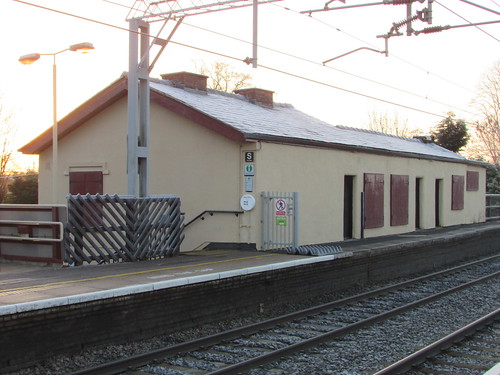
Penkridge Station - the boarded-up station building on the Up platform.
I was quite surprised when the automatic ticket machine, in an exposed location outside the unmanned station, correctly sold me a return ticket to Liverpool but, waiting on the platform with chilling feet my doubts about the wisdom of the trip returned. The passenger information displays did not appear to be working but the long-line public address delivered a couple of pre-recorded general safety messages before announcing my train, which arrived only a minute late. Eight waiting passengers boarded with me and I readily found a seat. The Class 350 Electric Multiple Unit was quite warm and we made good time to Stafford, where a large crowd of passengers joined the train.
We left Stafford on the Down Fast and we sped past the Norton Bridge Flyover (opened earlier in the year and described in my earlier post Return to Manchester) where I was just able to spot the old Down Slow, now out of use and partly lifted, which is now replaced by a new line which loops away to the west before rejoining the original alignment to the north of the flyover.
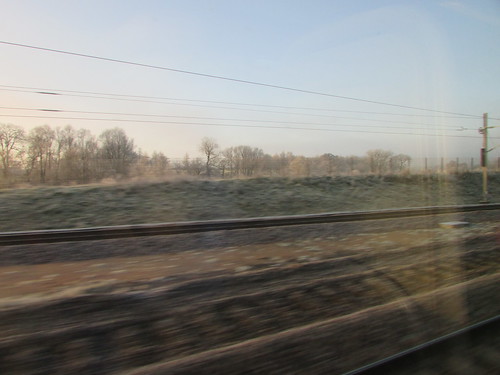
Norton Bridge: (top to bottom) new Down Slow rejoining original route, old Down Slow lifted, Up Slow.
The train made a long, slow approach to Crewe (without actually stopping at South Junction, as is often the case) but whether this was signals, weather conditions or otherwise I couldn't tell. Some passengers got off but many more joined the train. We left Crewe on the Down Fast but we seemed to be at reduced speed so we were falling behind the schedule. Stops at Winsford, Hartford, Runcorn and Liverpool South Parkway all added more passengers so on arrival at Liverpool Lime Street I doubt that there was a spare seat in the four coach train. Arrival was around 20 minutes 'down'. I purchased an All Areas 1-day 'Saveaway' ticket (valid on buses, Merseyrail trains, local trains and the ferry) from the friendly booking clerk at the booking office and made my way underground to the platform on the Wirral Line of Merseyrail.
The Class 507 and 508 Electric Multiple Units operated by Merseyrail are some of the oldest rolling stock in use on the national network but they still manage to provide an intensive well-used service. After James Street station, the single-line Liverpool Loop opened by British Rail in 1977 allows city-bound trains to serve Moorfields, Lime Street (Low Level) and Central before stopping again at James Street, now leaving the city. At Lime Street (Low Level), I passed through the new, automatic ticket barriers and caught the first train, bound for Chester, for the two stops to James Street.
A flight of steps and a lift returned me to street level where I was relieved to find it not too cold with a cheerful sun although the frost was still apparent. I walked towards Pierhead and considered my options. I've developed the habit of making a visit to the locomotive 'Lion' in the Museum of Liverpool before crossing the river on that icon of Liverpool, the Mersey Ferry. Incidentally, there are various links about 'Lion' and my involvement in the section The Museum of Liverpool, 'Lion' and the Old Locomotive Committee of the post here.
I knew that the first ferry was at eleven o'clock and hourly thereafter. With our late arrival in Liverpool, I wondered whether I'd need to revise the plan but, by walking faster and making my visit to the museum brief, I arrived at the ferry booking office in time to obtain a boarding pass for the 11:00 sailing, even snatching a quick 'shot' of Liverpool's 'Three Graces' on the way.
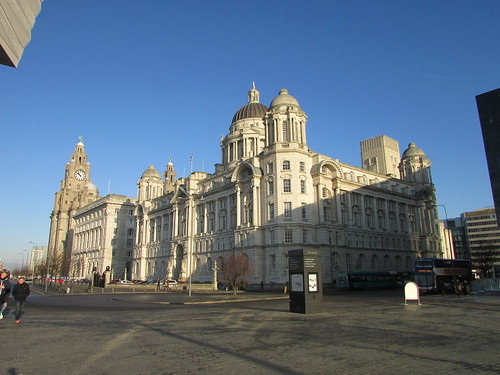
Return to Merseyside: Liverpool's 'Three Graces'.
'Snowdrop' was a few minutes late arriving at Pierhead but, once the gangway was in place, the long queue of passengers quickly boarded.
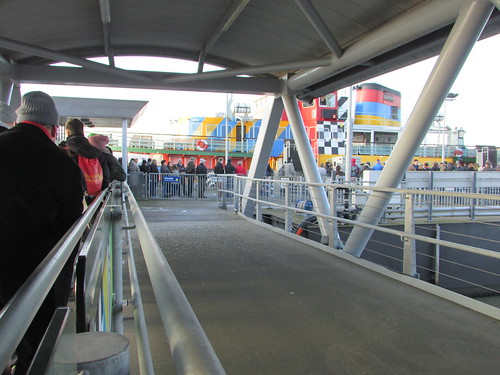
Boarding the 11:00 ferry.
As we boarded, I spotted 'Stolt Pelican' making its way upstream on the Birkenhead side of the river. Through the magic of marine Automatic identification system data, made available by a number of specialist shipping companies via the internet, on my return home I was able to determine that the ship, a chemical/oil products tanker of 5,797 tonnes deadweight had left Delfzijl (Netherlands) on December 25th for Ellesmere Port. By the time I made my checks at home, the ship had already left Ellesmere Port and was in the Irish Sea, destination Thamesport. There's a little about the Stolt fleet in the section By Ferry to Pierhead of the post here.
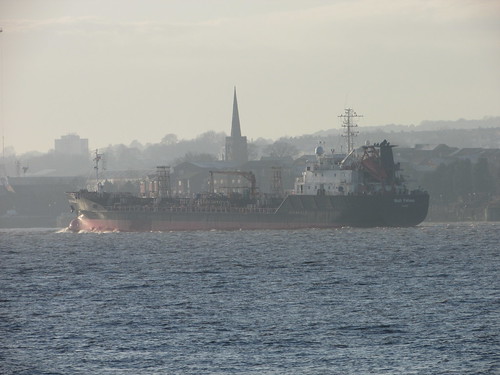
'Stolt Pelican', heading for Ellesmere Port.
'Snowdrop' was still in the 'DAZZLE' livery I complained about in the section The River Mersey of the post here. The ferry had docked at Pierhead heading upstream but, as soon as it cast-off, it turned seawards and gave us views of the dockland to the north of Pierhead. Before long, the Captain had turned upstream again to head diagonally for the floating landing stage at Seacombe. Mid-channel, the river was more troubled and a wind had picked up, discouraging me from disembarking at Seacombe (which I'd done a year previously).

Seacombe Landing Stage.
As we approached the floating pontoon, the Captain turned the ship again so that we moored with the bow pointing downstream. Looking across the river to the new 'Liverpool2' dock at Seaforth, I recorded the massive Chinese-built container cranes waiting for business, attended by a host of smaller gantry cranes, all looking very smart in their red and white livery. The Peel Ports site here has information about progress of the 'sea trials' at 'Liverpool2'.

The new 'Liverpool2' facility at Seaforth, viewed from Seacombe.
Within a few minutes, passengers had disembarked, more had joined and we were on our way upstream again for Birkenhead Woodside, this time with a very sharp wind which threatened to remove my cap. The Offshore Windfarm Support Vessel 'Seacat Defender', also heading upstream, almost matched our speed for a few moments as I took a picture. Liverpool is one of the shore locations supporting the extensive Irish Sea wind farm installations. My earlier post Llandudno includes a section on Offshore Wind Turbines.
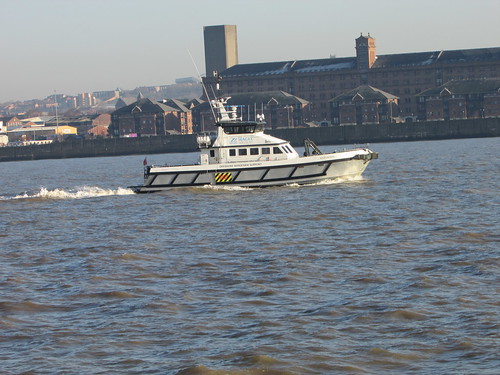
Seacat Services Offshore Windfarm Support vessel 'Seacat Defender'.
As we passed the remaining entrance to the Great Float of Birkenhead Docks, I managed a picture of the rolling lift bridge which takes Tower Road across the 100 foot channel. I described visiting this bridge on foot in the section Tower Road Bridge of the post Birkenhead and New Brighton by train (Part 2).
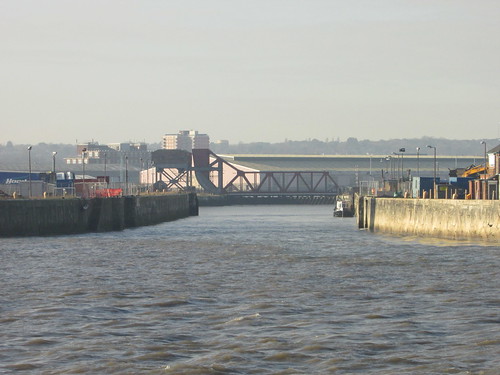
Tower Road Rolling Lift Bridge.
There was no ferry at the 12 Quays Terminal as we passed but I took a picture of the 3-lane vehicle bridge which connects the quay to the floating pontoon.
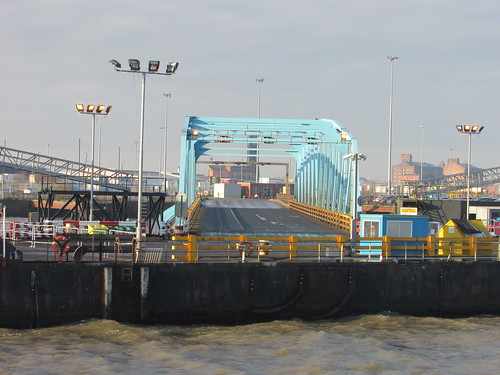
3-lane vehicle bridge connecting dock to pontoon at 12 Quays Terminal.
As we approached Birkenhead Woodside landing stage, the thin 'messenger line' thrown by the deckhand on 'Snowdrop' was caught by the man on the landing stage across his extended arm and he hauled in the slack, followed by the heavy mooring lines to which the thin line was attached.
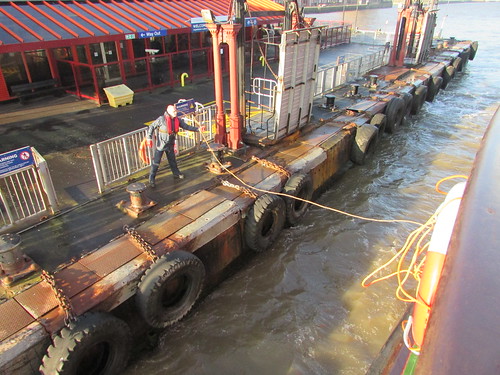
Birkenhead Woodside, catching the 'messenger line'.

Birkenhead Woodside, receiving the mooring lines.
With the loop in the mooring cable slipped over a bollard, the slack was adjusted by the deckhand on 'Snowdrop' as the Captain used the engines to bring the ship alongside - a task requiring great skill in the difficult currents of the Mersey. Watching the 'messenger lines' being thrown always reminds me of the 'practice courts' for the Line Handlers which I saw during my Partial Transit of the Panama Canal in 2008, described in the post here.
I disembarked, with other passengers, at the end of the always-enjoyable 'nautical' phase of my visit. More passengers boarded, whilst some remained on board for the last leg of the triangular journey back to Liverpool Pierhead which operates every hour.

'Snowdrop' at Birkenhead Woodside.
Once on shore, the wind abated and in bright sun I walked to Hamilton Square station to continue my explorations by train.
Go to Part 2 ...
Related posts on this site
I've written about Liverpool a number of times. Most are referenced in the post Liverpool (again).
My Pictures
Where necessary, clicking on an image above will display an 'uncropped' view or, alternately, all the pictures from this and earlier trips may be selected, viewed or downloaded, in various sizes, from the albums listed:-
Return to Merseyside (This trip).
Merseyrail (Earlier trips).
